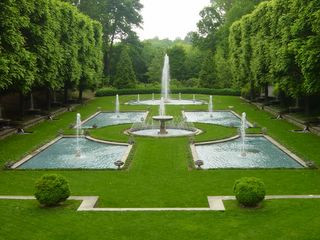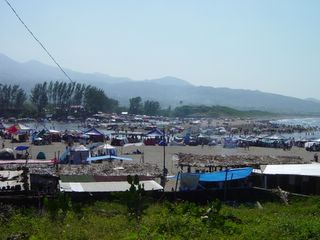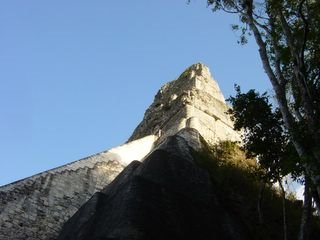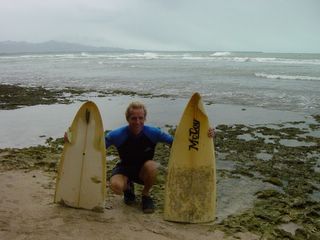waaaaaahhhh
Wednesday, April 04, 2007
Tuesday, June 13, 2006

Italy? France? Nope... This is America. The century of prosperity which has seen the US come to dominance in World affairs has spawned more than armies, cars and skyscrapers. Perhaps we are too cynical- maybe in a few centuries this era will be seen as one of glorious human acheivement instead of evangelism, environmental destruction and economic imperialism. Whether in the museums, great houses, cities or state parks, modern America produces wonders of human creativity on a vast scale.

Saturday, April 29, 2006

Bush's America 1... From outside the security fence the grey monsters loom against a leaden Texas sky. To enable oil companies to keep up with the spiralling demand for fuel oil GW has recently relaxed environmental constraints. This vast project is on land which until recently was a protected state park, owned by the people of America for their use and for the conservation of their environment. It is now behind razorwire and the property of LNG inc.


Glastonbury on Sea! Semana Santa, Mexico's most celebrated national holiday. About 30 million people take to the water- estuaries, lakes, rivers, anywhere to wallow the afternoon away with a feast, plenty of beer and as big a sound system as can fit on top of everything else in the pick-up. This was Monte Pio... 10000 people, two loos and one lifeguard. Hectic stuff


Strangely, this surrealist garden in Northern Mexico, now being reclaimed by the jungle, was built by an eccentric Englishman. It's a parent's nightmare with spiralling concrete stairways to nowhere, precipitous waterfalls and crumbling walkways over deep chasms. The children, inevitably were all over it!

Tuesday, April 11, 2006
Privations
Privations 1.
The time we have spent traveling this year has given us an insight into the world of those who spend their entire lives on the road, or with limited living space. It has not been without some difficulties; from the point of view of a family used to the comforts of first world living, as we do, in a large house, in a well-watered, highly developed and economically wealthy society.
For all of us the adjustment to cramming in to the bus meant a shift in attitude. No space is personal other than the strict confines of one's own time and space on the mattress. Even this has to be shared on a regular basis: Suzanne & I fold our bed away during the day to make room for everyone to live. For the children this often means finding a slumbering parent in situ when trying to find a quiet space in their own bunks during the hot afternoons.
The priority of stowing “necessities” such as school books, bikes, tools, surfboards, leaves little room for the usual surplus plastic tat that builds up in bedrooms and cupboards at home. Television has been off the menu. The children have been thrown onto their own resources; and with limited materials have responded by making fabulous toys, carving, moulding, pasting, taping, stitching, knotting and generally astounding us with the number and variety of ways in which simple objects can be modified, or mixed to create days of entertainment.
Water shortage is a real issue in many parts of the dry tropics. In some areas, such as the remote deserts of Baja access to any fresh water at all may be in question, whilst in large parts of Central America fresh water may be plentiful, but contaminated with pollution from agricultural or urban waste and run-off. This translates to simple inconveniences for travelers: if there isn't any water for flushing the lavatory, whether on the bus or in a campsite, then everyone has to put up with the smell until some can be obtained. (The worst moments on the bus in this respect arise if the toothbrushes haven't been stowed properly and they fall in as we negotiate a pothole or twisting mountain road.!) Just going without a proper wash or being unable to shower, when the days are so hot, the road so dusty; is something we have had to get used to.
These are not life threatening matters of course- but they are certainly beyond the usual comfort zone that cushions our lives back home.
Privations:2
Which brings us to the question of what life is like for the poorest of those who do call Central America home. The following observations are simply a product of passing through and watching, talking, sometimes staying for a few days, with the people who live in the diverse geographic environments of this region.
Most disturbing for us as parents, is the number of children who are at work, supplementing the family income, or playing an apparently essential part in the daily struggle for survival. This is clearly linked to the relative poverty of a particular area, for example it is not so obvious in Coastal Guatemala or El Salvador, where tourism, an evolving middle class and fertile agricultural lowlands provide a degree of economic opportunity. In rural and mountainous areas of Nicaragua and Honduras however, it is prevalent. We have regularly seen children, some very young and many of primary school age, engaged in freelance “road maintenance” tasks. In practice this meant standing by the side of the road with a shovel, filling in potholes during gaps in the traffic and begging for coins as payment.
In Chiapas, despite the efforts of the Zapatistas to bring greater government attention to the plight of the region's poor; the children of Mayan Indians are employed making and selling crafts in the markets and streets; whilst children regularly ply the congested traffic jams in towns and cities from southern Mexico to Southern Nicaragua with drinks, newspapers, fruit, sweets. Throughout the dry tropical and de-forested areas of Guatemala, Nicaragua and Honduras children are seen carrying large bundles of firewood, or heavy flasks of water, along seemingly endless roads or paths, sometimes miles from the nearest obvious settlement. This doesn't all take place during school hours, but undoubtably much of it does. Whenever and wherever, it has been uncomfortable to witness as we cruise by on our holiday.
In Nicaragua, the poorest country in the Western hemisphere, a publicly paid professional such as a teacher, or policeman may earn $90-100 (about $50 sterling) per month. It doesn't take a great deal of imagination to see where this places the income levels of semi-subsistence farmers in remote villages. Such low income levels means correspondingly low levels of Government revenue and so basic public services that we take for granted are non-existent or expensive to obtain via the private sector.
One visible effect of low income levels includes the collection, treatment and disposal of domestic and industrial waste. Wherever you travel in Mexico and Central America you can tell whether an area has had a prosperous recent history or a hard struggle, by the strength of the smell of untreated sewage, the size and distribution of the garbage piles. It is difficult sometimes, for those of us who have led such easy, sanitised lives, to understand the collective mentality of a community which lives alongside the revolting product of its existence, without any apparent effort being made to sort it out. But surely only those who have no choice can properly judge why, or how this has come about. One thing is sure: poverty can be pretty unpleasant for those who live with it.
Figures and statistics, which provide governments and aid agencies with “indicators of development”, manifest themselves in the real world in the form of chilling personal experiences. On one dirt road in the South West of Nicaragua we picked up a hitch hiker, Roberto. His hand and wrist was a swollen, septic mess following an accident in the fields with his machete. The accident had happened a few days before and we asked if he had seen a doctor, or was going to see a doctor. No, he wasn't. None was available locally and the cost of treatment should he make the journey was beyond his means anyway. Amputees are commonly seen on the streets in Central America.
Even in the centre of the sophisticated tourist honeypot of Granada, we were reminded of the ever present hunger faced by many children of Nicaragua. Eating a cheap lunch in the city square we were approached by children Peony's age, first begging for change and then, distressingly, asking for our left over scraps of food.
The struggle to lift the family out of poverty leads many workers to make huge sacrifices by migrating from home, to work somewhere more prosperous in order to send money back. This seems a particularly cruel effect of the poverty trap in this region because overwhelmingly, family is of such paramount importance in the lives of these resilient people. Wherever we have been we have encountered migrant workers who speak longingly of home, describe the journeys they undertake to see loved ones.
Epi, for example was the housemaid for our landlords where we stayed with Julie and Jill at Tamarindo in the tourist- wealthy Nicoya Peninsular of Costa Rica. Her husband, parents and several children live over the border in her native Nicaragua, the entire family dependent on her income from her work, far from home. She traveled home once a month for a couple of days, to see them all, take them her wages. In Belize we met Manuel, a taxi driver from Guatemala, who spoke softly of his family and his occasional visits to his loved ones. This was a pattern repeated so often that it became hard to ignore as a prevalent trait. Overwhelmingly these migrants are engaged in low paid, service sector or agricultural work.
The distribution of migrant workers also gives us an idea of the relative wealth of their home lands. Millions of Mexicans now live and work in the US, sending their wages home. In Mexico meanwhile there are large numbers of Guatemalans and Salvadoreans working the tomato and cane fields. In Belize the tourist and sugar cane industries are served partly by Guatemalans and Hondurans. Nicaraguans gravitate North and especially South to the relative wealth of Costa Rica and Panama.
For many of these economic migrants the move involves exchanging the love and support of family and home, for a tough and lonely life of grinding hardship, in the lowest paid sectors of their chosen country of work. It is pretty sad to talk with them and realise the sacrifice they make; it is even worse that in many cases the effort they make is met with a racist and discriminatory response by the middle classes of the countries they move to and serve.
The long term effect of insecurity is perhaps, above all else, the most damaging to the prospects for a people in their efforts to make life better . Whether through war, government and private sector corruption, or natural disaster; the incentive and ability to improve things is suppressed, without the confidence that any efforts made will be rewarded with long term gains.
The history of Colonial exploitation and relentless political upheaval since has made for a turbulent background against which people in Central America have had to battle. Throw in occasional violent hurricanes and devastating earthquakes which have destroyed, in the bat of an eyelid, a whole nation's infrastructure; and you can see why things have been difficult for humans to keep moving ahead, why the ugly face of poverty has been so hard to eradicate from so beautiful and environmentally rich a region.
It seems to us as passing observers however, that the latent energy, goodwill, optimism and generosity of the people who live here will prevail over the negative forces which make the struggle such a long, hard, slog. There are signs that optimism may not be unfounded: economic stability is spreading south, with Inflation and political turmoil under control in Mexico and currency rates between the countries of Central America similarly stable. Steady improvements in the security situation since the disastrous US/ Soviet sponsored battles of the 1970s and early 80s has recently brought in increasing levels of foreign investment, tourism and trade to Salvador, Honduras and at last, Nicaragua (although alarming numbers of guns are visible throughout the region). Prices for some of the cash crops (such as sugar and Coffee) on which Nicaragua and Honduras are heavily dependent, and which plummeted at the end of the 90s have improved. There may even be an Oil bonus on the way in the region if rumours in Belize are correct (although how much benefit this will bring to environment, and to the the rural poor remains to be seen).
In Nicaragua one legacy of the Sandanista era has been a strong sense of collective and locally inspired effort: community housing projects, local organic co-operatives, working women's groups: these are visible signs that modern, progressive, inclusive projects are underway. Similarly contemporary concepts such as eco-tourism and re-forestation projects are visible in Honduras which, given the opportunity, time and stability they need, may bring some relief to the poorest people of the region.
Thursday, March 30, 2006
Quickpost
Quick update from Belize... all well and taking a few days off the bus. Somehow managed to find our way out to the barrier reef in a Panga. Luckily this is a pretty laid back spot so no worries finding somewhere to stay, in fact a rastsa shack on the beach is home for the time being!! Funny to be speaking English after so many months of spanglaish.
Back to Mexico next week, it's going to seem like coming home after the adventures of Central America.
Monday, March 20, 2006
Heading North!!
We are on the Honduras, Guatemala border, visiting the Copan Ruins. Peony has done some new photos at last. Good girl.



















